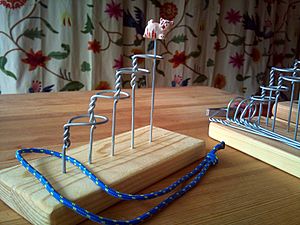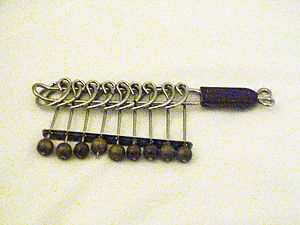Baguenaudier facts for kids
The Baguenaudier is a super cool puzzle where you have to free a loop from a set of rings. These rings are linked together on pillars. The loop can be made of string or a solid piece.
You might also know this puzzle by other names like the Chinese Rings, Cardan's Suspension, Cardano's Rings, Devil's Needle, or the Five Pillars puzzle.
History of the Puzzle
People think this puzzle was first invented a long, long time ago in China. We don't know exactly when or by whom. Some stories say that a Chinese general named Zhuge Liang created it in the 2nd or 3rd century.
The name "Baguenaudier" comes from the French word for "time-waster." French farmers sometimes used this puzzle as a simple lock.
Other Similar Puzzles
There are many puzzles that are like the Baguenaudier. Some of these include The Devil's Staircase, Devil's Halo, and the Impossible Staircase. Another similar one is the Giant's Causeway, which has an extra pillar with a ring on it.
Solving the Puzzle
Solving the Baguenaudier puzzle can be quite a challenge! But mathematicians have found clever ways to figure out the fewest moves needed to solve it.
A French mathematician named Édouard Lucas studied this puzzle in the 1800s. He also invented another famous puzzle called the Tower of Hanoi. Lucas found a way to solve the Baguenaudier using ideas similar to how you solve the Tower of Hanoi. This involves a special kind of counting system called binary and something called Gray codes.
For a puzzle with a certain number of rings, there's a specific minimum number of steps to solve it. It gets much harder as you add more rings!
See also
 In Spanish: Baguenaudier para niños
In Spanish: Baguenaudier para niños




